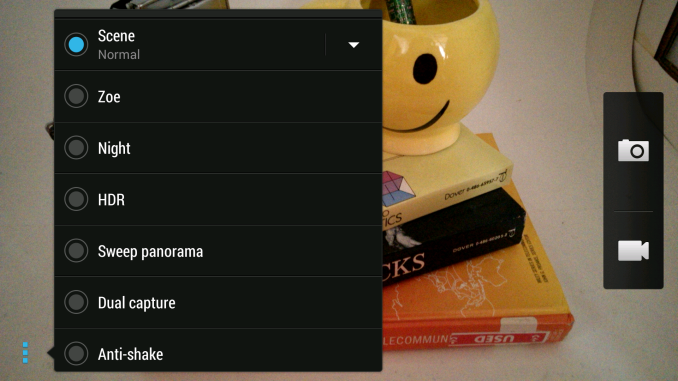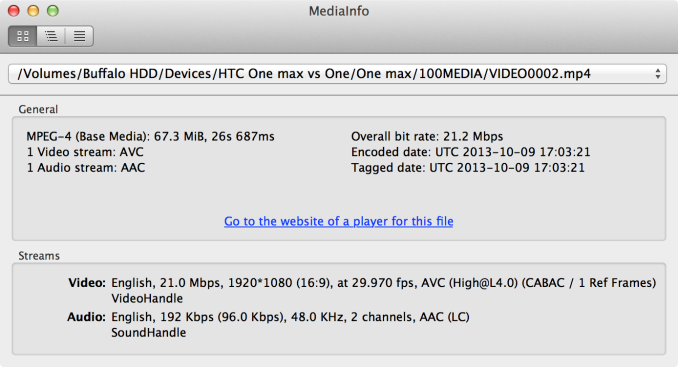HTC One max Review - It's Huge
by Brian Klug on October 28, 2013 10:00 AM EST- Posted in
- Smartphones
- HTC
- Mobile
- One
- Snapdragon 600
- Android 4.3
- One max
On the camera side we see HTC’s continued use of the 4 MP UltraPixel camera sensor on the back, with 2.0 micron pixels and 1/3" size. It’s the same CMOS sensor from ST (VD6869), and the same optics on top, with 3.8mm focal length and F/2.0 aperture. What’s different is that the One max doesn’t have OIS (Optical Image Stabilization), just like the One mini. That’s a bit unfortunate since OIS was one of the real highlights of the One, and we’ve seen another OEM follow suit with the inclusion of OIS to good success (LG’s G2) and will likely see Samsung do the same. On the front facing camera we have an Aptina AS0260 CMOS sensor with 2.1 MP resolution and 1.4µm pixels.
| HTC One Camera Specifications | |||||
| Device | HTC One | HTC One max/mini | |||
| Sensor Size and Type | 1/3" BSI CMOS | 1/3" BSI CMOS | |||
| Resolution | 4.0 MP 16:9 Aspect Ratio (2688 x 1520) | 4.0 MP 16:9 Aspect Ratio (2688 x 1520) | |||
| Focal Length | 3.82mm | 3.82 mm | |||
| F/# | F/2.0 | F/2.0 | |||
| Optical System | 5P | 5P | |||
| OIS | 2-axis +/- 1 degree, 2 kHz sampling | No OIS | |||
My thoughts about the HTC One camera system have definitely evolved over time, though I’m still glad HTC took a big risk and went this way, I’d like to see resolution traded off a bit less in the next generation. Good imaging often takes a balanced approach, I’d love to see larger pixels somewhere around 1.65 µm and as many as possible while still being pragmatic about sensor size. I hate to bring up the iPhone 5s as a comparison point, but something without as far of a tradeoff would be great. I’m still a fan of the HTC One camera indoors where other cameras struggle, but outdoors the resolution tradeoff is definitely there. Losing OIS means losing one of the things about the One system that made it special and standout in my mind. I could understand it being gone in the One mini for cost reasons, but the One max really should’ve had it considering its mission – everything about the One, taken to the max.
There’s a couple new features in the camera as a part of Sense 5.5 as well. Dual capture has been added to the camera as a shooting mode. We’ve seen this from other OEMs – it allows the front facing camera to be superimposed on the rear facing camera, or vice versus.
It’s a great feature for taking a selfie in front of something while traveling, which is ultimately its primary use case, I guess. There’s also an ‘anti shake’ mode which seems to be an EIS enhanced mode, but again this doesn’t preclude getting blurry pictures when the One max takes longer exposures, from what I’ve found.
Gallery: Smartphone Camera Bench
With the exception the performance tradeoff that comes from lacking OIS (higher chance of getting blurry photos from hand shake), imaging performance on the One max is really unchanged versus the One or One mini. I’m not going to go into super great detail here, but again I’d love to see the future One series a bit more resolution without trading off too much sensitivity.
Video
The One max has the same set of video modes as the other One, normal 1080p30, slow motion video, fast HD (720p60) and Video HDR (1080p30). In addition the shot in shot mode also works in video, so you can have yourself superimposed over video of whatever you’re shooting as well.
Video is recorded at a maximum of 1080p30 H.264 high profile with a 21 Mbps bitrate, and stereo audio. 1080p30 is great, but it’d be awesome to see 4K UHD video record which I was spoiled by on the Note 3, that’s another thing that’s a matter of SoC and CMOS needing a bit more.
I took videos on the One max at the standard bench location (MP4) and also compared to the One with OIS to illustrate the tradeoff in stabilized video that comes with its removal. I think it’s fairly easy to make the case that it should’ve been there. I also swear I wiped down the One max front facing glass to prevent glare, but the One max video shows some haze from light leakage. I’d love to see more OEMs move to coated sapphire cover glass on the camera, something I don’t believe HTC has.























































197 Comments
View All Comments
Steven JW FCK - Monday, October 28, 2013 - link
"I’ve said my part already on microSD cards and the fact that they’re going the way of the dodo in smartphones, I just don’t need one anymore, and definitely not at the expense of build quality. It is convenient not having to use a SIM ejector tool though, even if I carry one around all the time anyways"I'm sorry, you carry around a sim card removal TOOL, at all times with you, and you don't think micro SD cards are relevant any more? I don't think you are qualified to write a review about this phone if that is your opinion. I mean you would rather use a cloud/pay the extra money for inbuilt storage, than use an affordable, replaceable, micro SD card... But you paid to have a sim card removing tool, and then chose to wear it upon you? At all times?...
10101010 - Monday, October 28, 2013 - link
I'm glad to see that you are not letting this issue with Brian's Klug's anti-local storage bias slip away. The sad fact of the matter is that most reviewers are notoriously biased. Some are biased due to ignorance, some are biased due to payoffs, many are biased due to both.The fact that Brian Klug has some sort of hate trip on SD cards is not surprising. All the big money players in the US want to get rid of local storage so they can (a) increase data revenues (b) mine and sell more data (c) comply with NSA directives to collect more data on people. So we have one of Anandtech's top tier reviewers going off on how bad micro SD cards are, i.e. implying you cannot build a high quality phone if it has a micro SD card. And then the same reviewer disparages the many millions of people who depend on SD cards every day as some sort of unimportant minority.
It seems obvious to me that objectivity and balance have been lost, that the reviewer is just a tool pushing an agenda.
Brian Klug - Monday, October 28, 2013 - link
I clearly am an agent of the NSA and this is a long-game to get all of your data. Clearly.-Brian
nerd1 - Monday, October 28, 2013 - link
So with the same logic laptop should get rid of SD slots too, especially macbooks with SD card sticking out. Heck, earlier macbook pros didn't have one!fenneberg - Monday, October 28, 2013 - link
Still dissing, eh..PC Perv - Tuesday, October 29, 2013 - link
I don't think what 10101010 said translates to your intelligence, lol. For one you are not really a big money player. I think what 10101010 meant is that you happily obey.Dentons - Wednesday, October 30, 2013 - link
Wow, your arrogance is astounding.Stop listening to your friends in the phone manufacturing business for a minute and start listening to the technical crowd that makes up the majority of your readership.
piroroadkill - Monday, October 28, 2013 - link
Hey, HTC, how about the Butterfly S?dawheat - Monday, October 28, 2013 - link
I'm having a tough time liking the One Maxx - it's such a big phone for .2" screen increase over the Note 3, with the on screen buttons eating a decent part of the increased real estate.Also the Note 2 was pretty heavy, the Note 3 was a nice decrease in weight. The difference in weight between the Note 3 and One Maxx is close to the difference in weight between the iPhone 5 and Note 3.
Mondozai - Monday, October 28, 2013 - link
Well, the fingerprint issue isn't really resolved yet. We will have to wait and see how the security aspect goes. Still, my guess is that Apple is probably better at this generally than Android OEMs, specifically 2nd tier ones like HTC.This seems like an unnecessary review, especially as many much bigger launches were ignored. Who will buy HTC One Max? Very few people. HTC is going down anyway.
I'm still waiting for the mother lode: Nexus 5.
I also hope Brian can overcome his WP8 bias and review a few Nokia phones out this fall.